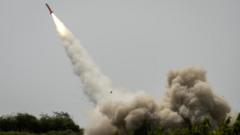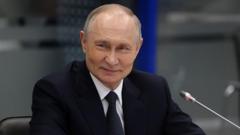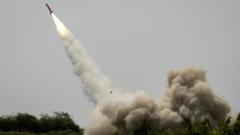The Zaporizhzhia nuclear power plant, now under Russian control, is witnessing infrastructure development as indicated by satellite images. Greenpeace has documented the construction of power lines meant to establish a connection to the facility, which Moscow plans to restart despite international condemnation and safety risks highlighted by experts. The findings, which may have significant implications for both local and global safety, place pressure on international dialogues surrounding peace negotiations.
**Russia's Ambitious Moves to Restart Captured Nuclear Plant in Ukraine Raise Concerns**

**Russia's Ambitious Moves to Restart Captured Nuclear Plant in Ukraine Raise Concerns**
A recent Greenpeace report reveals Russia's efforts to link a seized Ukrainian nuclear power plant to its own grid, escalating fears of potential nuclear hazards amidst ongoing conflict.
As per the Greenpeace report shared with The New York Times, over 50 miles of new power lines and pylons are being constructed between Mariupol and Berdyansk, regions occupied by Russian forces. Analysis of these images suggests the project aims to link power lines to a substation near Mariupol that feeds into the Zaporizhzhia plant, located approximately 140 miles away. Shaun Burnie, a nuclear expert with Greenpeace Ukraine, emphasized this as concrete evidence of Russia's intent in the region, as completion of these lines could facilitate restarting operations at the plant.
While the precise motives behind Moscow's actions remain ambiguous, experts are concerned about the implications of reactivating the facility amid ongoing hostilities. Operating the plant without comprehensive safety measures could heighten the risk of a nuclear incident, given its location near active combat zones. Furthermore, experts predict that several other lines will be necessary to securely connect Zaporizhzhia to the Russian grid, suggesting a timeline that could further complicate the conflict in Ukraine.
In light of these developments, international entities and local communities push for urgent discussions to reassess the safety and operational status of the Zaporizhzhia plant and surround areas, highlighting the complexity of energy reliance in wartime scenarios. The potential ramifications of Russia's plan not only threaten regional stability but could also have wider implications for nuclear safety standards globally.
While the precise motives behind Moscow's actions remain ambiguous, experts are concerned about the implications of reactivating the facility amid ongoing hostilities. Operating the plant without comprehensive safety measures could heighten the risk of a nuclear incident, given its location near active combat zones. Furthermore, experts predict that several other lines will be necessary to securely connect Zaporizhzhia to the Russian grid, suggesting a timeline that could further complicate the conflict in Ukraine.
In light of these developments, international entities and local communities push for urgent discussions to reassess the safety and operational status of the Zaporizhzhia plant and surround areas, highlighting the complexity of energy reliance in wartime scenarios. The potential ramifications of Russia's plan not only threaten regional stability but could also have wider implications for nuclear safety standards globally.




















